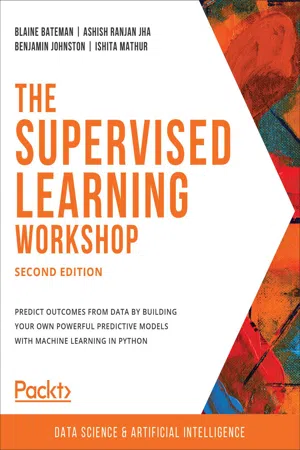
The Supervised Learning Workshop
A New, Interactive Approach to Understanding Supervised Learning Algorithms, 2nd Edition
Blaine Bateman, Ashish Ranjan Jha, Benjamin Johnston, Ishita Mathur
- 490 pagine
- English
- ePUB (disponibile sull'app)
- Disponibile su iOS e Android
The Supervised Learning Workshop
A New, Interactive Approach to Understanding Supervised Learning Algorithms, 2nd Edition
Blaine Bateman, Ashish Ranjan Jha, Benjamin Johnston, Ishita Mathur
Informazioni sul libro
Cut through the noise and get real results with a step-by-step approach to understanding supervised learning algorithms
Key Features
- Ideal for those getting started with machine learning for the first time
- A step-by-step machine learning tutorial with exercises and activities that help build key skills
- Structured to let you progress at your own pace, on your own terms
- Use your physical print copy to redeem free access to the online interactive edition
Book Description
You already know you want to understand supervised learning, and a smarter way to do that is to learn by doing. The Supervised Learning Workshop focuses on building up your practical skills so that you can deploy and build solutions that leverage key supervised learning algorithms. You'll learn from real examples that lead to real results.
Throughout The Supervised Learning Workshop, you'll take an engaging step-by-step approach to understand supervised learning. You won't have to sit through any unnecessary theory. If you're short on time you can jump into a single exercise each day or spend an entire weekend learning how to predict future values with auto regressors. It's your choice. Learning on your terms, you'll build up and reinforce key skills in a way that feels rewarding.
Every physical print copy of The Supervised Learning Workshop unlocks access to the interactive edition. With videos detailing all exercises and activities, you'll always have a guided solution. You can also benchmark yourself against assessments, track progress, and receive content updates. You'll even earn a secure credential that you can share and verify online upon completion. It's a premium learning experience that's included with your printed copy. To redeem, follow the instructions located at the start of your book.
Fast-paced and direct, The Supervised Learning Workshop is the ideal companion for those with some Python background who are getting started with machine learning. You'll learn how to apply key algorithms like a data scientist, learning along the way. This process means that you'll find that your new skills stick, embedded as best practice. A solid foundation for the years ahead.
What you will learn
- Get to grips with the fundamental of supervised learning algorithms
- Discover how to use Python libraries for supervised learning
- Learn how to load a dataset in pandas for testing
- Use different types of plots to visually represent the data
- Distinguish between regression and classification problems
- Learn how to perform classification using K-NN and decision trees
Who this book is for
Our goal at Packt is to help you be successful, in whatever it is you choose to do. The Supervised Learning Workshop is ideal for those with a Python background, who are just starting out with machine learning. Pick up a Workshop today, and let Packt help you develop skills that stick with you for life.
Domande frequenti
Informazioni
1. Fundamentals
Introduction
When to Use Supervised Learning

Python Packages and Modules
- NumPy (pronounced Num Pie and available at https://www.numpy.org/): NumPy (short for numerical Python) is one of the core components of scientific computing in Python. NumPy provides the foundational data types from which a number of other data structures derive, including linear algebra, vectors and matrices, and key random number functionality.
- SciPy (pronounced Sigh Pie and available at https://www.scipy.org): SciPy, along with NumPy, is a core scientific computing package. SciPy provides a number of statistical tools, signal processing tools, and other functionality, such as Fourier transforms.
- pandas (available at https://pandas.pydata.org/): pandas is a high-performance library for loading, cleaning, analyzing, and manipulating data structures.
- Matplotlib (available at https://matplotlib.org/): Matplotlib is the foundational Python library for creating graphs and plots of datasets and is also the base package from which other Python plotting libraries derive. The Matplotlib API has been designed in alignment with the Matlab plotting library to facilitate an easy transition to Python.
- Seaborn (available at https://seaborn.pydata.org/): Seaborn is a plotting library built on top of Matplotlib, providing attractive color and line styles as well as a number of common plotting templates.
- Scikit-learn (available at https://scikit-learn.org/stable/)...
Indice dei contenuti
- The Supervised Learning Workshop
- Preface
- 1. Fundamentals
- 2. Exploratory Data Analysis and Visualization
- 3. Linear Regression
- 4. Autoregression
- 5. Classification Techniques
- 6. Ensemble Modeling
- 7. Model Evaluation
- Appendix